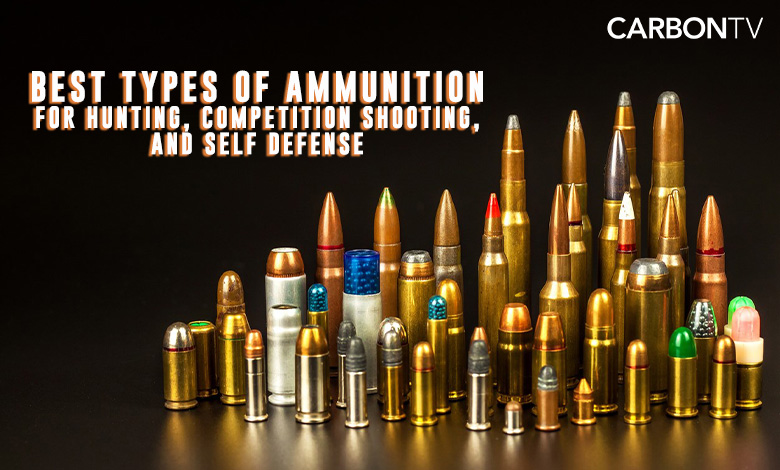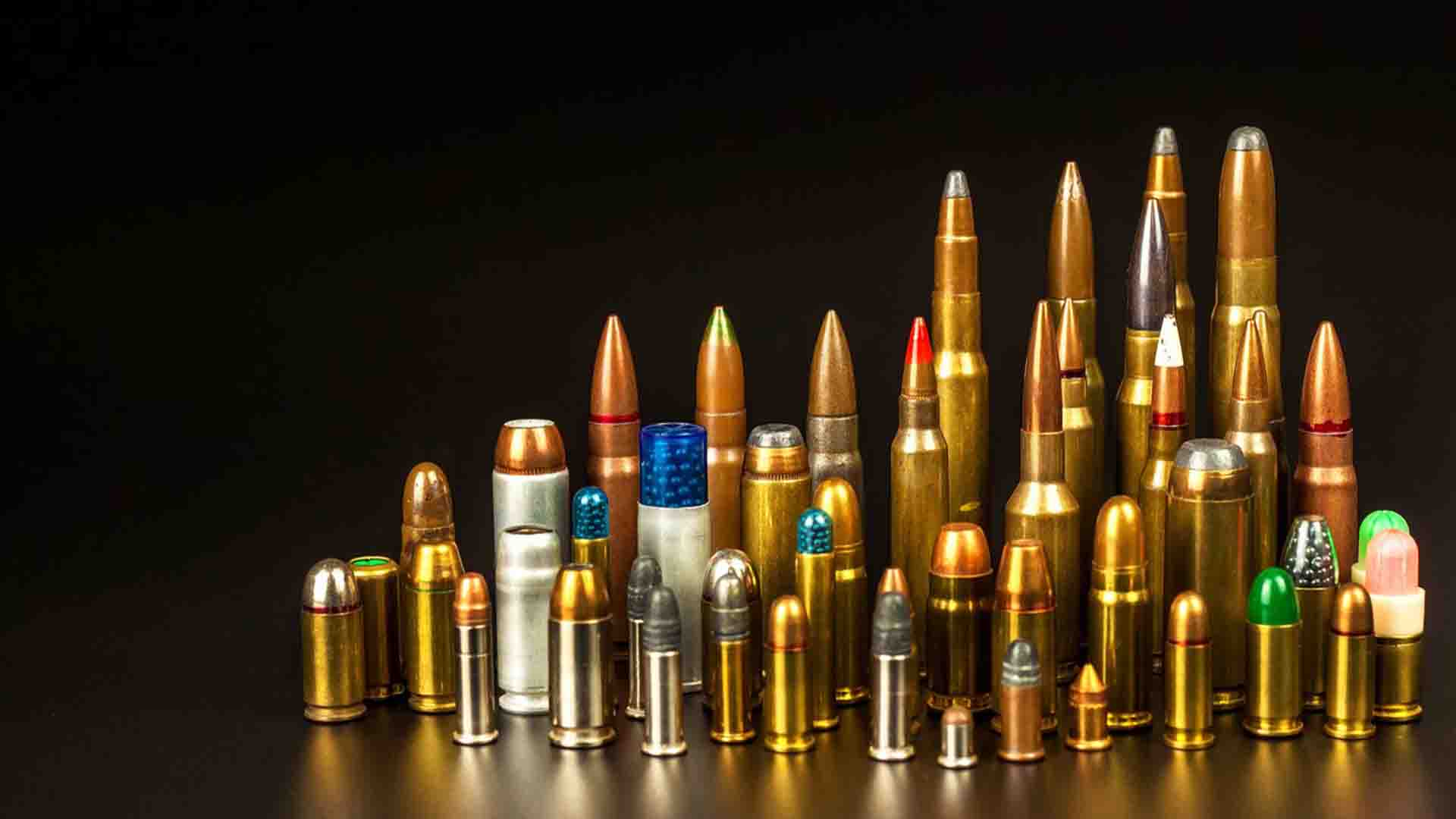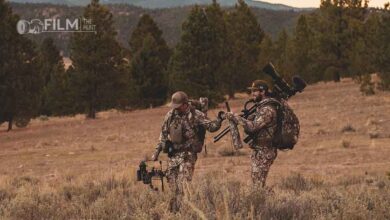Best Types of Ammunition for Hunting, Competition Shooting, and Self Defense
Sponsored by Hinterland Outfitters

In today’s technology-laden world, choosing the best types of ammunition for Hunting, Competition Shooting, and Self Defense is no easy task. Depending on your firearm, several options affect how a bullet reaches its target. Ballistic coefficient, velocity in feet per second, and energy in foot-pounds, to name a few.
Best Types of Ammunition for Personal Defense
Choosing the correct cartridge to protect your family has much greater importance than price, whether you’re using a revolver or an AR-15. If a handgun is used, look for a cartridge that has extreme reliability, maximum energy, and causes the most damage with a single shot.
Choose a hollow-point for self-defense and hunting situations. Hollow-point construction means the bullet expands on impact and causes a more lethal hit. The bullet deforms on impact, resembling a mushroom. Hollow-points begin to slow after leaving the muzzle, giving them more stopping power.
If your firearm of choice is a shotgun, choose a buckshot load. Anything less, and the damage may not be enough to stop an intruder. With any self-defense scenario, you want a quick end to the situation.
Hornady Critical Defense Handgun Ammunition, 9 mm, 115 grain, flex-tip
Critical Defense Ammo is optimized for concealed carry weapons fired from short-barreled handguns. The 115-grain FTX Hornady Critical Defense bullet consistently meets the FBI standard of 12” penetration. The flex-tip bullet features a red polymer insert to ensure reliable expansion on impact.
Speer Gold-Dot Personal Protection, 380 ACP, 90-grain Hollow-Point
This cartridge has been proven in the field to meet FBI standards of protocol. The Speer Gold-Dot offers one of the highest muzzle velocities for a 380 ACP. This hollow-point cartridge is more than capable of stopping an intruder.
Best Types of Ammunition for Competitive Shooting
Most entry-level competitors go for the cheapest full metal jacket ammo. As you become serious about the sport, competitors look for an edge, no matter how small. The correct ammunition provides a substantial competitive advantage.
FMJ rounds work fine for entry-level handgun competitors; they are an affordable and reliable cartridge. Full metal jacket cartridges and brass casings work OK in rifle competitions. With competitive shooting experience comes an understanding of the importance of ballistics and bullet construction.
As an example, choosing the right casings—aluminum and steel are not the best options and are prone to reliability issues. Brass is OK; stainless steel casings are the best. Stainless steel casings have a self-lubricating quality and come out of the muzzle cleanly. Use a boat-tail bullet shape for best precision.
Federal Premium 6.5 Creedmoor, 140 grain, 2725 FPS
No other cartridge has impacted long-range precision as much as the 6.5 Creedmoor. Competitive shooters can have a legitimate 1600-yard supersonic capability with the right load. Most experienced competitors prefer the long-range ballistics of the 6.5 Creedmoor over other cartridges.
Power Factor
Organizations have a power factor metric to separate shooters into their respective divisions. Power factors do not depend on caliber but rather on bullet weight and velocity. Multiply the bullet weight by velocity and divide by 1000 to get the power factor for the ammo you plan to use.
If you shoot a lighter bullet, there is less efficient muzzle velocity to reach the proper power factor. Always shoot a heavier cartridge if possible.
Winchester 308 Power Max Bonded
Competitive shooters love the hollow-point 180-grain Winchester with its 2620 FPS. Capable ranges for the 308 are about 600 yards and 1000 yards with a custom load. The 308 has an arched trajectory that may sometimes carry it off-target; however, it is a capable cartridge in competition.
Bullet Weight and Recoil
Use a heavier cartridge in competition because of the steel targets shooting organizations use. Lighter handgun rounds require several shots to knock down a target. 55- and 62-grain rifle rounds won’t have this problem because of their velocity. Another factor is that heavier rounds are not affected by wind, so long-range precision is better.
Shooting organizations require multiple rounds of fire. Heavier rounds help manage recoil for accurate follow-up shots. Use subsonic rounds in certain situations; you do not want a heavy cartridge shooting really fast. A small detail that helps is to use slow-burning powder; fast-burning powder produces too much recoil. When competing for championships, small details add up.
Hunting Ammo
The rule of thumb for hunting ammunition is “the heavier the game you hunt, the heavier the bullet.” Heavier ammo carries more energy at impact, aiding in momentum for deeper penetration. Another way to put this concept is as a basic rule of physics: double the weight, double the energy. However, doubling the velocity quadruples the energy.
No matter the caliber, lighter bullet weights have a flatter trajectory. As an example, a 150-grain Winchester Silver Tip drops 7.3 inches at 300 yards. The same bullet, at 180 grains, has a drop of 7.9 inches. That is not a lot of a difference in drop at 300 yards. Increase the range to 500 yards, and the difference could mean a hit or miss.
Another issue to consider is cross-winds. Heavier bullets deflect less if the cartridge is launched at maximum velocity and has a similar shape as a boat-tail or spire point. Also, heavier bullets kick more than lighter rounds. If your shoulder is sensitive to recoil, choose a lighter round.
Browning Controlled Expansion 300 Winchester Magnum
If your target is a 900 lb. Elk at 1100 yards downrange, this is the cartridge that can down the animal with a single shot. The 180-grain polymer-tipped copper bullet is built for deep penetration and a devastating impact. The 3000 FPS brings a lot of energy to the rifle; however, recoil can be harsh.
Shotgun Shells
No other firearm has taken advantage of technology more than the modern shotgun. New configurations and materials have brought new excitement to shotgun sports, home defense, and hunting. Choosing the right shell—ask any modern shotgun expert—is all about the number of buckshot, its type, and size.
Best Types of Ammunition for Home Defense
A classic choice of ammo is the 00 buck (.330 inch in diameter), with the primary reason being stopping power. This popular shell can fire as many as 10 to 15 .380 handgun loads at close range. Another popular option is the No. 4 buckshot for the same reason: it discharges a considerable amount of buckshot with a single blast.
Slugs are the ultimate choice of power for a shotgun. Depending on the gauge, slugs may over-penetrate and lead to immense damage, so be careful to make the right decision.
Federal Vital-Shok Buckshot, 12 Gauge 3”, 00 buckshot with 15 pellets at 1100 fps
Federal features a patented spiral stacking process that ensures a dense shot pattern. The Vital-Shok shell has more than enough pellets with incredible velocity to down any intruder. The Vital-Shok is also great at deer hunting.
Best Types of Ammunition for Competition
Trap, skeet, and sporting clay have seen skyrocketing interest in the last few years, with plenty of young shooters coming into the sport. Look at any quality online retailer, and there are dozens of ammo choices for competition.
Start with the recommendation of experienced shooters and go with either the 7 ½, 8, or 9 shot. Gain experience in the trenches and hone in on what suits your style the best.
Federal Premium Gold Medal Grand Paper 12 Gauge, 2.75”, #7.5 lead shot, and 1235 fps
The Federal Premium is a favorite of sporting clay shooters with a paper hull design and less recoil. The shell is designed to produce uniform, dense shot patterns, shot after shot.
Final Word
Take a look at the ballistics charts of Federal, Hornady, Winchester, and others to realize the growing complexity of choosing the best ammunition online. It is no longer a matter of looking at a catalog of one or two calibers and then choosing.
The complexity of choosing the best types of ammunition is manageable for experienced shooters but becomes increasing complex for new shooters coming into the sport.
Once you have the right setup and ammo for your firearm, there is nothing like shooting.
_________________________________________________
About CarbonTV LLC
CarbonTV LLC is an online streaming platform that offers a diverse range of outdoor-themed content, catering to outdoor enthusiasts, hunters, anglers, and sports lovers. With a wide selection of live cams, shows, films, and podcasts, CarbonTV provides an immersive experience in the world of hunting, fishing, and outdoor adventures.
For more information and to explore our content, visit our website at https://www.carbontv.com
Explore CarbonTV
Live Cams | Live TV | Shows | Films | Podcasts | CarbonTV Outfitter Services | Firearm Safety | Store
Follow CarbonTV on Social Media:
For more exciting outdoor content and updates, make sure to visit our blog at https://blog.carbontv.com.



This statement is not even close to accurate “Hollow-points begin to slow after leaving the muzzle, giving it more stopping power.” It makes me think the author is not actually knowledgeable about ammo or guns.